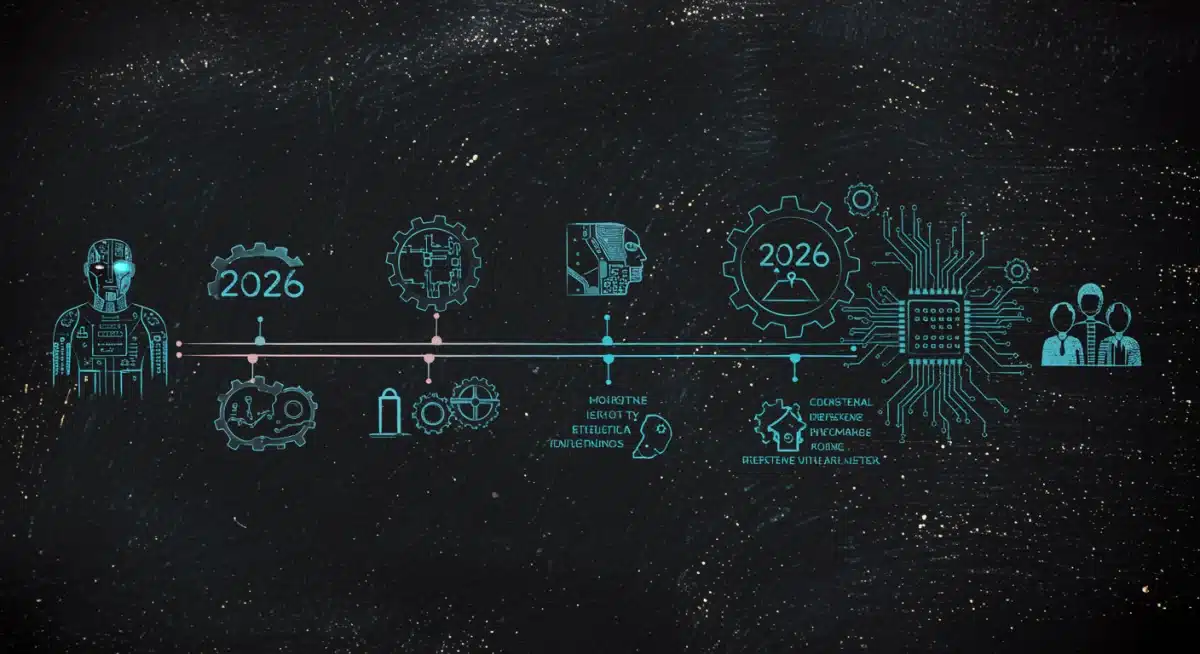AI Ethics & Governance: US Tech Policies by 2026

The evolving landscape of AI ethics and governance in the US is critical, with new policies emerging to shape technological development and ensure responsible innovation by 2026.
The rapid advancement of artificial intelligence presents both unprecedented opportunities and significant challenges. As AI systems become more integrated into daily life, the need for robust AI ethics governance US frameworks has never been more pressing. This article delves into the recent updates and three key policies poised to profoundly affect US tech development by 2026, ensuring innovation proceeds responsibly.
The Imperative for AI Ethics and Governance in the US
The United States stands at a pivotal juncture, balancing its role as a global leader in AI innovation with the critical responsibility of ensuring these technologies serve humanity ethically and equitably. The sheer scale of AI’s potential impact across sectors—from healthcare and finance to national security and daily commerce—necessitates a proactive approach to its oversight. Without clear ethical guidelines and governance structures, the risks of bias, misuse, and unintended consequences could rapidly outweigh the benefits.
This evolving landscape demands continuous vigilance and adaptation from policymakers, industry leaders, and the public alike. Establishing clear boundaries and accountability mechanisms is not merely a regulatory burden but an essential component of fostering public trust and ensuring the sustainable growth of the AI industry. The goal is to cultivate an ecosystem where AI innovation thrives within a framework that prioritizes human values and societal well-being.
Why Ethical AI Matters Now More Than Ever
- Mitigating Bias: Addressing algorithmic bias in AI systems to prevent discriminatory outcomes in areas like hiring, lending, and criminal justice.
- Ensuring Transparency: Developing mechanisms for understanding how AI systems make decisions, promoting accountability and trust.
- Protecting Privacy: Safeguarding personal data from misuse by AI, especially with the rise of increasingly sophisticated data processing capabilities.
- Promoting Fairness: Striving for equitable distribution of AI’s benefits and minimizing its potential harms across all segments of society.
Ultimately, the push for AI ethics and governance in the US is about more than just compliance; it’s about shaping a future where technology empowers rather than endangers, and where innovation is synonymous with responsibility. The decisions made today will reverberate for generations, influencing the very fabric of our technologically advanced society.
Policy 1: The National AI Initiative Act of 2020 and Its Evolution
The National AI Initiative Act of 2020 marked a significant stride in the US government’s commitment to AI leadership, establishing a coordinated program across federal agencies to accelerate AI research and development. While initially focused on R&D, its ongoing evolution increasingly incorporates ethical considerations as a foundational element. This act serves as the bedrock upon which subsequent policies and ethical guidelines are being built, aiming to ensure American competitiveness while fostering responsible innovation.
Its implementation has seen the creation of various working groups and task forces dedicated to exploring the ethical implications of AI across different applications. These bodies are tasked with developing best practices, identifying potential risks, and proposing solutions that align with democratic values. The emphasis is on a holistic approach that integrates ethical thought into every stage of AI development, from conception to deployment.
Key Pillars of the National AI Initiative’s Ethical Framework
The evolving framework under this act emphasizes several critical areas:
- Research Ethics: Funding ethical AI research to understand and mitigate societal risks.
- Education and Workforce Development: Training a new generation of AI professionals with a strong foundation in ethical principles.
- International Collaboration: Working with allies to develop shared ethical norms and standards for AI.
- Public Engagement: Fostering public dialogue and understanding about AI’s ethical dimensions.
By 2026, we anticipate seeing more concrete outcomes from these efforts, including standardized ethical review processes for federally funded AI projects and potentially new educational curricula. The Act’s adaptive nature allows it to respond to emerging ethical challenges, making it a dynamic instrument for guiding AI’s trajectory responsibly.
Policy 2: NIST’s AI Risk Management Framework
The National Institute of Standards and Technology (NIST) has emerged as a crucial player in the development of practical AI governance tools. Its AI Risk Management Framework (AI RMF), released in early 2023, provides a voluntary, flexible, and comprehensive guide for organizations to manage the risks associated with designing, developing, deploying, and using AI systems. This framework is not a prescriptive regulation but rather a set of best practices intended to help organizations integrate ethical considerations into their operational workflows.
The AI RMF is structured around four core functions: Govern, Map, Measure, and Manage. Each function outlines specific activities and outcomes designed to help organizations systematically address AI risks, promote trustworthy AI, and ensure responsible innovation. Its voluntary nature encourages widespread adoption by allowing organizations to tailor its application to their specific contexts and risk appetites.

Implementing the AI RMF: A Phased Approach
Organizations are encouraged to implement the AI RMF using a phased approach:
- Govern: Establish an organizational culture of AI risk management, defining roles, responsibilities, and oversight.
- Map: Identify and characterize AI risks, including potential harms, biases, and vulnerabilities, throughout the AI lifecycle.
- Measure: Develop metrics and methods to assess, analyze, and track AI risks, evaluating their severity and likelihood.
- Manage: Implement strategies and controls to mitigate identified AI risks, continuously monitoring and adapting as needed.
The framework’s emphasis on continuous improvement and stakeholder engagement is vital. By 2026, the AI RMF is expected to become an industry standard, influencing how companies approach AI development and deployment, thereby fostering a more consistent and responsible approach to AI across the US tech sector. Its flexibility makes it adaptable to various industries and AI applications, from consumer-facing products to highly sensitive government systems.
Policy 3: State-Level AI Initiatives and Their Impact
Beyond federal efforts, several US states are actively developing their own AI policies and ethical guidelines, often responding to specific local needs or industry concentrations. States like California, New York, and Colorado have been at the forefront, introducing legislation concerning data privacy, algorithmic transparency, and the use of AI in critical applications like employment and law enforcement. These state-level initiatives complement federal efforts, creating a multi-layered governance structure.
The decentralized nature of these policies can lead to a patchwork of regulations, posing challenges for companies operating across state lines but also allowing for innovative approaches tailored to regional contexts. For instance, some states might focus heavily on consumer protection in AI, while others prioritize ethical considerations in public sector AI deployment. The variety of approaches can serve as a testing ground for different regulatory models.
Diverse State Approaches to AI Governance
- Data Privacy Laws: States like California (CCPA/CPRA) are influencing how AI systems handle personal data, emphasizing consumer rights and data minimization.
- Algorithmic Transparency: New York City’s law on automated employment decision tools requires audits for bias, setting a precedent for transparency in AI-assisted hiring.
- AI in Public Services: States are exploring guidelines for AI use in areas like criminal justice and welfare, focusing on fairness and accountability.
- Task Forces and Commissions: Many states have established advisory bodies to study AI’s impact and recommend policy actions, ensuring ongoing assessment.
By 2026, we anticipate a more harmonized landscape as successful state-level policies influence federal legislation, or as interstate compacts emerge to streamline compliance for businesses. The interplay between state and federal regulations will be crucial in defining the overall AI ethics and governance framework in the US.
Challenges and Opportunities in AI Ethics and Governance
Navigating the complex terrain of AI ethics and governance presents both formidable challenges and immense opportunities. One of the primary challenges lies in the rapid pace of technological advancement, which often outstrips the legislative process. Crafting regulations that are flexible enough to adapt to new innovations without stifling progress is a delicate balancing act. Additionally, the global nature of AI development means that purely national policies may not be sufficient, necessitating international cooperation.
The opportunity, however, is to establish the US as a global leader not only in AI innovation but also in responsible AI development. By embedding ethical principles and robust governance mechanisms, the US can foster public trust, attract top talent, and create a competitive advantage in the international AI landscape. This proactive approach can lead to more resilient and trustworthy AI systems that benefit society as a whole.

Overcoming Governance Hurdles
- Regulatory Agility: Developing legislative frameworks that can evolve with technology, possibly through principles-based regulations rather than rigid rules.
- Interdisciplinary Collaboration: Fostering stronger ties between technologists, ethicists, legal experts, and policymakers to create comprehensive solutions.
- Public-Private Partnerships: Encouraging collaboration between government, industry, academia, and civil society to share knowledge and resources.
- Global Harmonization: Working towards international standards and agreements to ensure consistent ethical AI practices worldwide.
The ongoing dialogue and iterative development of policies will be key to addressing these challenges effectively. The period leading up to 2026 will be critical for solidifying these frameworks and demonstrating the US’s commitment to ethical AI leadership.
The Future Landscape of US AI Policy by 2026
Looking ahead to 2026, the US AI policy landscape is expected to be more defined and integrated, moving beyond foundational acts to more specific implementation strategies. We anticipate a greater emphasis on sector-specific AI regulations, addressing unique ethical challenges in areas like healthcare, autonomous vehicles, and critical infrastructure. The goal will be to create a comprehensive yet adaptable regulatory environment that supports innovation while safeguarding public interest.
This future will likely see increased enforcement mechanisms for AI policies, potentially including audit requirements, certification processes, and clear accountability frameworks for AI system developers and deployers. The convergence of federal and state efforts, possibly through preemption or model legislation, could lead to a more streamlined and predictable regulatory environment for businesses.
Anticipated Developments in AI Governance
Key developments expected by 2026 include:
- Sector-Specific Regulations: Tailored AI rules for high-risk applications in healthcare, finance, and defense.
- Enhanced Enforcement: Clearer penalties and accountability for non-compliance with AI ethical guidelines.
- International Cooperation: Stronger alliances with other nations to establish global norms for AI development and deployment.
- Public-Private Standards: A greater role for industry standards and certifications in demonstrating ethical AI adherence.
The continuous evolution of AI technology will necessitate an equally dynamic approach to governance, ensuring that policies remain relevant and effective. By 2026, the US aims to have a robust framework that not only fosters technological advancement but also champions the ethical deployment of AI for the benefit of all citizens.
| Key Policy | Brief Description |
|---|---|
| National AI Initiative Act of 2020 | Establishes federal coordination for AI R&D with increasing focus on ethical integration. |
| NIST AI Risk Management Framework | Voluntary guide for organizations to manage AI risks, promoting trustworthy AI development. |
| State-Level AI Initiatives | Diverse state policies addressing data privacy, algorithmic transparency, and public AI use. |
Frequently Asked Questions About AI Ethics and Governance in the US
The primary goal is to foster responsible AI innovation that aligns with human values, mitigates risks like bias and misuse, and builds public trust, ensuring AI benefits society equitably while maintaining US leadership in technology.
The Act, while primarily focused on R&D, increasingly integrates ethical considerations by funding ethical AI research, developing an ethically informed workforce, and promoting international collaboration on AI norms and standards.
No, the NIST AI Risk Management Framework is currently voluntary. It provides a flexible guide for organizations to manage AI risks, promote trustworthy AI, and integrate ethical considerations into their operational workflows, aiming to become an industry standard.
State-level policies complement federal efforts by addressing specific local needs, particularly in data privacy, algorithmic transparency, and AI use in public services. They create a multi-layered governance approach, often serving as testing grounds for new regulatory models.
By 2026, we anticipate more defined, integrated, and sector-specific AI regulations. This includes enhanced enforcement mechanisms, increased international cooperation, and a greater role for public-private standards to ensure responsible and trustworthy AI deployment.
Conclusion
The journey towards robust AI ethics governance US is a dynamic and multifaceted endeavor, shaped by federal mandates, practical frameworks, and diverse state-level initiatives. As we approach 2026, the concerted efforts to establish clear ethical guidelines and accountability mechanisms are crucial for harnessing AI’s transformative potential while mitigating its inherent risks. The policies discussed—the National AI Initiative Act, NIST’s AI Risk Management Framework, and various state-led efforts—collectively form a comprehensive approach designed to ensure that AI development in the US remains both innovative and deeply responsible. This ongoing commitment to ethical stewardship will define the future of technology and its impact on society for generations to come.





